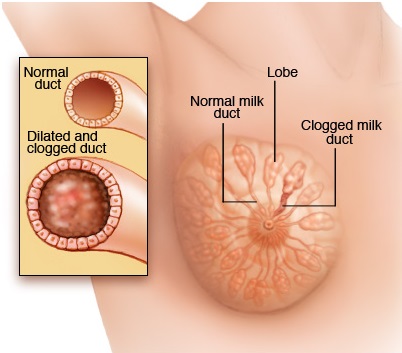Mammary Duct Ectasia Causes, Symptoms, Diagnosis and Treatment

What Is Mammary Duct Ecstasia ?
Mammary Duct Ectasia, also known as plasma cell matisis, is condition of the lactiferous duct which is marked by the duct becoming blocked or clogged.
It occurs when the milk duct behind the nipple widens, which causes the duct walls to thicken and the duct fills with fluid.
The most common cause of greenish discharge from the nipple, mammary duct ectasia is known to mimic breast cancer.
Although, the symptoms if present may mimic breast cancer, mammary duct ecstasia does not increase the risk of developing breast cancers.
It is dubbed to be a disorder of the pre or post menopausal age, with average age of onset lying between 45 to 55 years.
Usually marked by lack of symptoms other than fluid discharge, the condition may improve without proper treatment. However, in case of severe form of mammary duct ecstasia, treatment may be sought.
Causes Of Mammary Duct Ecstasia:
The exact cause of mammary duct ecstasia is still unknown. Probable causes of mammary duct ecstasia may include the following:
- Breast tissue changes due to aging
- Involution may occur
- Smoking
- This may causemilk ducts to widen, which in turn may lead to inflammation and eventually mammary duct ectasia
- Nipple inversion
- Nipple inversion may cause mammary duct ecstasia
- It is a symptom of cancer
Symptoms Of Mammary Duct Ecstasia:
The following symptoms may be exhibited by those suffering from mammary duct ecstasia:
- A dirty white, greenish or black nipple discharge from the nipples
- Tenderness in the nipple
- Redness of the nipple and the surrounding area
- A lump in the breast
- thickening near the clogged duct
- Inverted nipple
Diagnosis Of Mammary Duct Ecstasia:
Mammary duct ecstasia can be diagnosed via:
- Medical history
- Physical examination
- Diagnostic ultrasound of the nipple and areola, to evaluate the milk ducts beneath the nipple
- Diagnostic mammography, which may help in evaluating the breast tissue
Treatment Of Mammary Duct Ectasia:
Generally, mammary duct ecstasia tends to improve on its own. If it doesn’t, the following treatment options are available:
- Pain medication, to relieve discomfort
- acetaminophen (Tylenol, others)
- ibuprofen (Advil, Motrin IB, others)
- Surgery
- The affected milk duct is surgically removed.
By : Natural Health News




